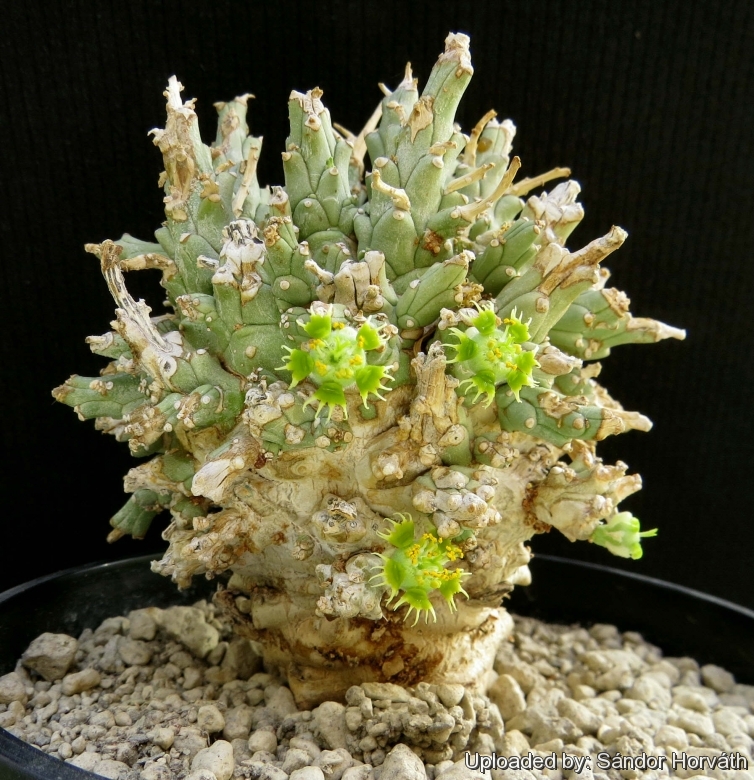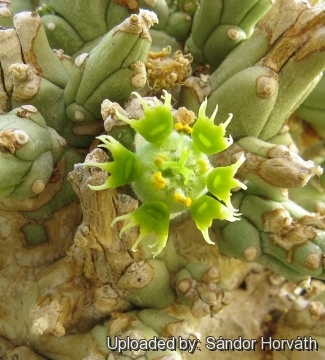




Your support is critical to our success.
- Encyclopedia of SUCCULENTS
- Encyclopedia Index
- Families
- Genera
- Species
- Euphorbiaceae
- Euphorbia
- Caudiciforms
Since 4 Aug 2013
Accepted Scientific Name: Euphorbia friedrichiae Dinter
Neue Pfl. Deutsch-Sudwest-Afr. 29 1914. Dinter

Origin and Habitat: Euphorbia multiramosaSN|32350]]SN|32350]] is distributed on the desert plains of the Richterveld, from Vioolsdrift to Jakkalswater. Further recordings have also been made around Alexander Bay.
Altitude range: Approximately 600 metres above sea level.
Habitat and ecology: Nama Karoo Biome. Euphorbia multiramosaSN|32350]]SN|32350]] grows in a very dry area in reddish well-drained sand, in full sun, on level slope with very few associated plant species such as the bulbous Boophone distichaSN|1351]]SN|1351]]. Local abundance frequent but very scattered. It is threatened trampling of goat.
Synonyms:
Euphorbia friedrichiae Dinter
Neue Pfl. Deutsch-Sudwest-Afr. 29 1914.
Synonymy: 3
- Euphorbia friedrichiae Dinter
- Euphorbia multiramosa Nel
- Euphorbia namaquensis N.E.Br.
Description: Euphorbia multiramosaSN|32352]]SN|32350]] is a dwarf, rather ugly-looking, irregularly shaped, succulent shrublet to 30 cm tall, with a deep tap root merging into a fat subglobose main stem. The whole stumpy body of the plant is covered with very numerous branches all over, except at a small central area at the apex. The branches are short, rebranching, tapering to a long spine-like point which ultimately dries away, and are covered with very prominent elongated tubercles in spiral series. The flowers are dark cream coloured. Euphorbia multiramosaSN|32350]]SN|32350]] differs from the related Euphorbia namaquensisSN|32350]]SN|32352]] in having a more compact distribution of branches, the peduncles being less persistent than in E. namaquensis and the cyathia (specialized flowers) are always produced singly and not in small cymes like often seen in E. namaquensis. There are also other floral differences.
Stems: Main stem subglobose 20 cm high and about 12 cm thick, covered with very numerous branches all over, except at a small central area about 3 cm. in diameter at the apex, spineless but with some persistent remains of the peduncles on the branches. Branches 4 to 11 cm. long, 0.5 to 1.5 cm. thick, simple or frequently with secondary branchlets, tuberculate, tapering to a long spine-like point which ultimately dries away, glabrous, blue-green; tubercles rather distant, triangular, tipped with a white tooth.
Leaves: Linear, 8-40 mm long, margin red, with small teeth 2 mm apart produced in clusters on the growing tips of the branches and soon deciduous
Inflorescences: Cymes simple, several roduced on the upper quarter of the lower side branches, sessile or on short peduncles to less than 1.5 cm, persisting. Bracts 1-2, on the peduncle, fleshy, spathulate, hairy and persisting. Cyathia to 13 mm across covered outside with stiff, erect, white hairs, with 5 nectar glands 5 with transversely oblong lobes each with 4–8 whitish bifid processes c.2 mm long, yellowish-green to brownish within.
Male flowers: Pedicel below the joint of the filament covered with stiff white hairs.
Female flower: Ovary ovate, 2 mm. long, glabrous, on a short pedicel 1 mm long; styles 5 mm long.
Fruits: Subglobose, obtusely 3-angled, 8 mm in diameter, densely bristly, sessile.
Seeds: Subconical, slightly verrucose, with a keel down the face, variably brown mottled.
Notes: White et al.(1941) expressed doubt as to whether the two names Euphorbia multiramosaSN|32352]]SN|32350]] and Euphorbia namaquensisSN|32351]]SN|32352]] represented distinct species. E. multiramosa was also included under Euphorbia friedrichiaeSN|32352]]SN|32351]] in Bruyns et al. (2006). Williamson (2007) made extensive notes on E. multiramosa and E. namaquensis. He concluded that they represented distinct species, since ‘the general appearance of both plants is quite different... Cymes in E. multiramosa are only produced on the leeward aspect mostly from half to the lower third of the plant....the cymes are solitary with very short peduncles and the involucral glands smaller, sessile, horizontally curving outwards with 4–8 marginal processes. The capsules are glabrous and ± 8 mm in diameter. Euphorbia namaquensisSN|32350]]SN|32352]] has a single or up to two pairs of cyathia with elongated peduncles at branch apices and with involucral glands larger, shortly stipitate, suberect to erect and with 3–6 marginal processes and capsules densely pubescent 10–12 mm in diameter.’ In practice, the ‘general appearance’ of plants from north of Steinkopf (taken to be typical of E. multiramosa) and those from west of gamoep (taken to represent E. namaquensis) is identical; all the other features mentioned are actually very variable within populations. Consequently E. multiramosa and E. namaquensis differonly in the glabrous vs. pubescent capsules, though even this feature has been found to be variable in E. multiramosa. [P.V.Bruyns “Nomenclature and typification of southern African species of Euphorbia” Bothalia 42,2: 217–245 (2012)]
Bibliography: Major references and further lectures
1) Alain Campbell White, Robert Allen Dyer, Boyd L. Sloane “The succelent Euphorbisae (southern Africa)” Abbey garden press, 1941
2) Archer, R.H. & Victor, J.E. 2005. Euphorbia friedrichiae Dinter. National Assessment: Red List of South African Plants version 2015.1. Accessed on 2016/01/15
3) Eggli, U., ed. “Illustrated handbook of succulent plants: Dicotyledons”. 2002
4) “African Wildlife” Wildlife Society of Southern Africa., 1953
5) Neotype of Euphorbia multiramosa Nel [family EUPHORBIACEAE] The Bolus Herbarium (BOL), BOL139236 <http://plants.jstor.org/stable/10.5555/al.ap.specimen.bol139236> web 15 January 2016
6) Bruyns, P.V. “Nomenclature and typification of southern African species of Euphorbia.” Bothalia 42(2):217-245. 2012.
7) Bruyns, P.V. “, Mapaya, R.J. & Hedderso N. T. 2006. “A new sub-generic classification for Euphorbia (Euphorbiaceae) in southern Africa based on ITS and psbA-trnH sequence data.” Taxon 55: 397–420
8) Williamson G. 2007. “Notes of Euphorbia multiramosa Nel (Euphorbiaceae) and related species.” Euphorbia World 3. 8–18

Euphorbia multiramosa Photo by: Sándor Horváth
The gallery now contains thousands of pictures, however it is possible to do even more. We are, of course, seeking photos of species not yet shown in the gallery but not only that, we are also looking for better pictures than those already present. Read More...
Cultivation and Propagation: Mature specimen of Euphorbia multiramosaSN|32350]]SN|32350]] will not grow successfully when collected in habit, and like many other plants of the Richtersveld, is best left to live out its lonely life where nature has deemed it should. Seed-grown specimens are much more easy to grow and now readily available in cultivation. When cultivating Euphorbia multiramosaSN|32350]]SN|32350]] it must be remembered that the plants grow fully exposed in hot desert conditions.
Soil: It does best in a mineral soil, good drainage is essential. It is a slow growing long lived plant and once established, it will be content in its position and with its soil for years.
Exposure: It likes a sunny position, but can tolerate moderate shade, and a plant that has been growing in shade should be slowly hardened off before placing it in full sun as the plant will be severely scorched if moved too suddenly from shade into sun.
Water requirements: Water with care during the summer monthand then leave the soil to dry out for a considerable time. Keep dry in winter.
Propagation: It is propagated from seed sown during spring or summer. Germination occurs within 3 weeks. Flowering can be achieved within 5-8 years.
| Your Actions | |
|---|---|
| Back to Euphorbia index | |
| Back to Euphorbiaceae index | |
 |
Back to Succulents Encyclopedia index |
Privacy stantement - Terms and conditions - How to cite - About us - Feedback - Donate




